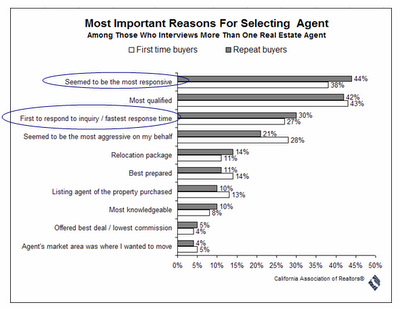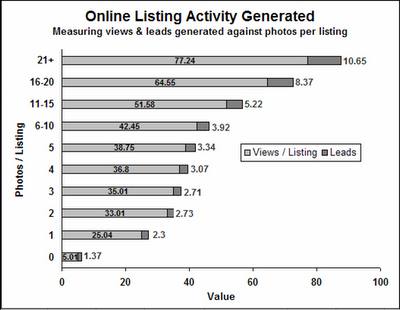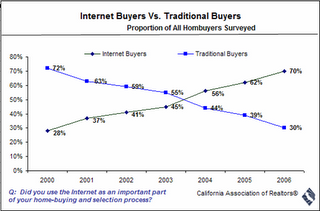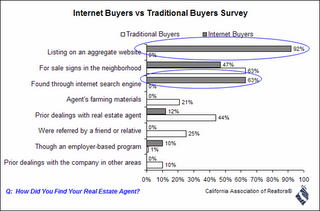White Paper Part VIII - Conclusion
Predictive Modeling
We’ve noted that the most important factor to increasing response is publishing better listing content. The most important factor in increasing conversion of inquiries into leads and sales is simply the quality, relevance and timelines of the response. The last piece of the lead generation/conversion story is a focus on generating deeper pipelines.
Let me explain.
Not all leads are created equal. Many generated directly from listings tend to be of hot prospects active in the home search process. Many others are of consumers who are further out in the home buying cycle. A study conducted by HouseValues, Inc. in 2005 indicates that the average consumer spends up to 16 months in the home search cycle. Leads created that are further out in the cycle represent future business for the brokerage, but if they are handled correctly. Brokerages that pay attention to these leads can create long term sales pipelines that before long turn into a regular stream of mature opportunities to route on to their sales force.
Reaching further upstream to consumers early in the home search process can also establish the brokerage as the go to source for research information, a reputation that can boost the company’s position and competitiveness in its market.
The lead incubation process begins with a solid lead capture solution. Your software needs to be able to establish lead criteria such as first visit, last visit, location, home search areas, home search price ranges, repeat view patterns, contact information, financial qualification information, contact history notes and other relevant website or portal activity. This information is extremely valuable in pursuing and communicating with those leads.
Typical lead incubation systems on the market today allow real estate companies to place leads into automated drip marketing systems. Leading solutions however have the ability to operate different campaigns based on a trigger system that places the lead on a relevant drip campaign based on the prospect’s activity on the site. Some of those systems may also allow brokerages to develop their own company specific drip campaigns. A state of the art system such as Point2 goes one more step. It identifies prospects that have been on a drip campaign and have now matured (i.e. they have turned into a hot prospect), as their home search activity increases or specific request for contact or information is registered. Hot prospects are then marked, and notification is sent to the brokerage or agent indicating contact must be made. A state of the art system such as Point2 goes one more step. It identifies prospects that have been on a drip campaign and have now matured (i.e. they have turned into a hot prospect), as their home search activity increases or specific request for contact or information is registered. Hot prospects are then marked, and notification is sent to the brokerage or agent indicating contact must be made.
A state of the art system such as Point2 goes one more step. It identifies prospects that have been on a drip campaign and have now matured (i.e. they have turned into a hot prospect), as their home search activity increases or specific request for contact or information is registered. Hot prospects are then marked, and notification is sent to the brokerage or agent indicating contact must be made.
Future lead management and incubation capabilities under development today will focus on predictive modeling. While current drip systems tend to provide home search notification and static drip campaigns, predictive modeling will take lead profile information and send ultra relevant static and dynamic content to the lead. The goal is to make the brokerage the source of research information right up until the lead is ready to engage a real estate agent to help narrow or close their home search.
Conclusion
With the vast majority of consumers using the Internet in their home search, brokerages need to advertise their inventory in as many ways possible to maximize exposure and leads. Today, this includes focusing on both natural and vertical search marketing. Listings are the most valuable marketing assets brokerages and their agents possess. Better listings (rich data) generates more buyer leads, which increases the chance a company’s listing is sold in-house. The most important step in converting those inquiries is to focus on responding immediately. Because agents are mobile and not sitting at their desk all the time, lead notification needs to become mobile, with text messaging.
Brokerages that focus on developing longer term lead pipelines will maximize the total number and percentage of leads that will eventually transact with someone within their organization.
These strategies are not simply nice to have. They are essential for the survival of traditional brokerage business model during this time of rapid change. Real estate companies that do not develop a complete online marketing and operating strategy will risk losing market share and will squander the opportunity to lead, as new waves of innovation enable better, more efficient and more cost effective marketing and lead conversion strategies.







 63% of Internet buyers started their search on an Internet search engine
63% of Internet buyers started their search on an Internet search engine If all this sounds like a lot of work, it is. But solutions such as Point2 Agent, Point2 Broker and Point2 Builder are designed to address these requirements, automatically optimizing listings pages for major search engines. The real estate professional needs to merely input listing data on simple web forms, and select structured feature sets. In other words, simply enter your listings and allow the underlying technology to manage search engine optimization for you. Further, the Point2 system gives each listing its own optimized URL, so it can be more easily crawled and indexed by search engines.
If all this sounds like a lot of work, it is. But solutions such as Point2 Agent, Point2 Broker and Point2 Builder are designed to address these requirements, automatically optimizing listings pages for major search engines. The real estate professional needs to merely input listing data on simple web forms, and select structured feature sets. In other words, simply enter your listings and allow the underlying technology to manage search engine optimization for you. Further, the Point2 system gives each listing its own optimized URL, so it can be more easily crawled and indexed by search engines.